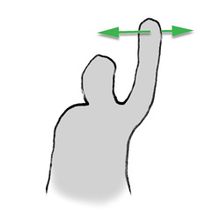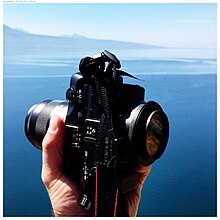Dualphotography is the photography technique of simultaneously taking two photographs of one scene, thus capturing a scene from both sides of the photographic device at once. In other words, it is the practice of creating a photographic scene from two opposing or complementary sides of a single real-world situation. Dualphotography can be used to capture both the subject and the photographer simultaneously, or both sides of a geographical place at once, thus adding a supplementary narrative layer to that of a single image.

Specific types of dualphotography include back-to-back photography and portal-plane photography. Stereoscopy is a specific kind of dualphotography, and while it is technically similar and would be compatible with the term, the latter is seldom used for it.
Etymology
The word "dualphotography" is a combination of "dual" from the Latin root dualis ("two") and the word "photography". Along these lines, the composite of two photos taken simultaneously from the same scene is called a "dualphotograph" or "dualphoto".
A related term is "bothie", coined by Nokia in 2017 to introduce their smartphones with front and rear cameras. A bothie in this case would be a photo captured through both cameras at the same time. The term is seldom used in English, dualphoto has gained more popularity being easier to pronounce and understand in other languages too.
Techniques
Back-to-back


Back-to-back dualphotography is done with two cameras taking pictures at 180 degrees opposition, thus excluding the photographer and camera from the scene. It has been popularized by smartphone apps, because smartphones typically have a camera in the front for selfies and another in the back for more traditional photographs. Triggering both cameras at the same time would allow the smartphone to capture dualphotos.
Sometimes two traditional cameras can also be attached together and mechanically synchronized to capture photos at the same time.

-
 Removing camera and photographer from a scene thanks to the dualphoto technique.
Removing camera and photographer from a scene thanks to the dualphoto technique.
-
 An intense moment at a soccer match in Madrid, catching the public and the players at once during a penalty.
An intense moment at a soccer match in Madrid, catching the public and the players at once during a penalty.
-
 A dualphoto in between two blossoming cherry trees.
A dualphoto in between two blossoming cherry trees.
-
 A filtered dualphoto (using the bootymachine.net inspired filter from the Duall Dualphoto app) of Geneva lake and the docks.
A filtered dualphoto (using the bootymachine.net inspired filter from the Duall Dualphoto app) of Geneva lake and the docks.
-
 A dualphoto of the food and its accompanying wine.
A dualphoto of the food and its accompanying wine.
-
 A dualphoto of the urban infrastructure.
A dualphoto of the urban infrastructure.
Portal-plane
Portal-plane dualphotography uses two distant cameras with GPS and gyroscopic abilities to capture dualphotos. The cameras are linked by means of wireless transmission and both client and server-side software. This technique effectively removes the space between the two cameras and creates a single scene between two geographical places with two photos being off-facing each other.
-
 An example of an ambiance / urban portal-plane dualphoto.
An example of an ambiance / urban portal-plane dualphoto.
-
 An example of a street portal-plane dualphoto.
An example of a street portal-plane dualphoto.
-
 An example of an abstract filtered (here with the square filter from the Duall Dualphoto app) portal-plane dualphoto.
An example of an abstract filtered (here with the square filter from the Duall Dualphoto app) portal-plane dualphoto.
-
 An example of a random portal-plane dualphoto.
An example of a random portal-plane dualphoto.
Equipment


Dualphotography requires a dualcamera. Modern smartphones with specific software can take dualphotographs, but hardware equipment, both digital and film-based can be found (usually custom built).
References
- "An introduction to Dualphotography". Medium.com Dual.Photo publication.
- "Here's How a 'Bothie' Is Different From a Selfie". Lifewire. Retrieved 2020-06-21.